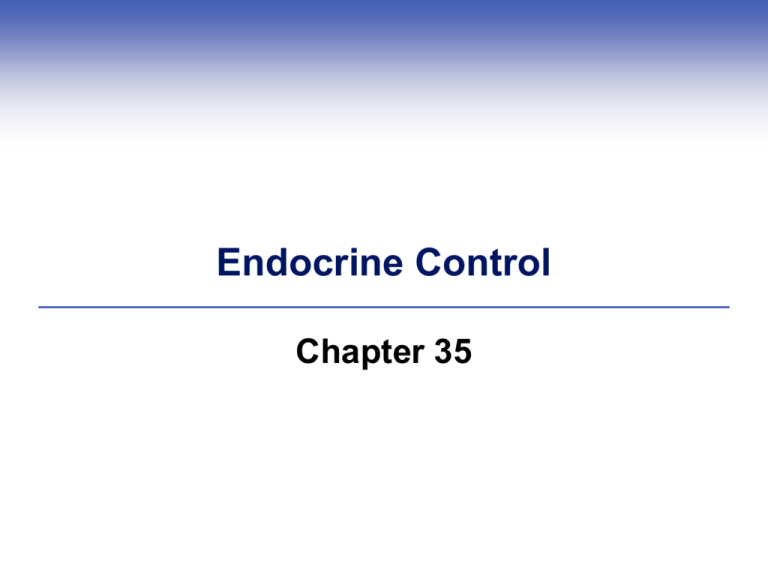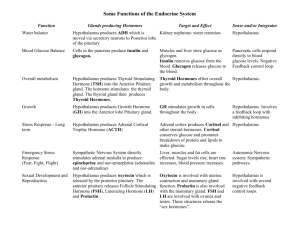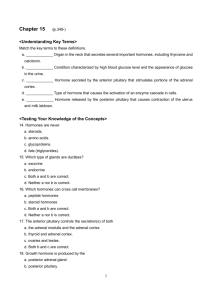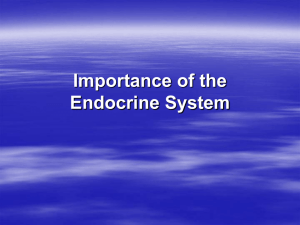Endocrine System
advertisement

Endocrine Control Chapter 35 Impacts, Issues Hormones in Balance Many chemicals we release into the environment (such as the herbicide atrazine) have disruptive hormonal effects 35.1 Introducing the Vertebrate Endocrine System Animal cells communicate with one another by way of a variety of short-range and long-range chemical signals Animal cells communicate with adjacent cells through gap junctions and by releasing molecules that bind to receptors in or on other cells Shot-Distance Signaling Neurotransmitters secreted by neurons diffuse across the synaptic cleft to the target cell Local signaling molecules, such as prostaglandins released by injured cells, affect only neighboring cells Long-Distance Signaling Animal hormones secreted into interstitial fluid enter capillaries, are distributed throughout the body, and have wide-reaching effects Pheromones diffuse through water or air and bind to target cells in other individuals (help integrate social behavior) Overview of the Endocrine System Hormones • Internal secretions carried by the blood that influence the activities of specific body organs Endocrine system • Glands and other hormone-secreting sources Nervous-Endocrine Interactions Nervous and endocrine systems interact • Both respond to the hypothalamus, a command center in the forebrain Most organs receive and respond to both nervous signals and hormones Hypothalamus Makes and secretes releasers and inhibitors, hormones that act in the anterior lobe of the pituitary. Pituitary gland Anterior lobe makes and secretes ACTH, TSH, LH, FSH (stimulate secre- tion by other endocrine glands), pro- lactin (acts on mammary glands) and growth hormone (affects overall growth). Adrenal glands (one pair) Adrenal cortex makes and secretes cortisol (affects metabolism, immune response), aldosterone (acts in kid- neys), small amount of sex hormones. Ovaries (one pair of female gonads) Make and secrete progesterone and estrogens (affect primary sex organs and influence secondary sexual traits). Testes (one pair of male gonads) Make and secrete testosterone and other androgens (affect primary sex organs and influence secondary sexual traits). closer view of the hypothalamus and pituitary gland hypothalamus pituitary gland Pineal gland Makes and secretes melatonin (affects sleep/wake cycles, onset of puberty). Thyroid gland Makes and secretes thyroid hormone (metabolic and developmental effects) and calcitonin (lowers blood calcium). Parathyroid glands (four) Make and secrete parathyroid hormone (raises blood calcium level). Thymus gland Makes and secretes thymosins (act in maturation of T cells, a type of white blood cell). Pancreas Makes and secretes insulin (lowers blood glucose level) and glucagon (raises blood glucose level). Fig. 35-2, p. 599 The Human Endocrine System Fig. 35-20, p. 615 35.2 The Nature of Hormone Action Cell communication involves three steps For a hormone to have an effect, it must bind to protein receptors on or inside a target cell Categories and Examples of Hormones Intracellular Receptors Steroid hormones are made from cholesterol and can diffuse across the plasma membrane Most steroid hormones form a hormone-receptor complex that binds to a promoter inside the nucleus and alters the expression of specific genes Receptors at the Plasma Membrane Large amine, peptide and protein hormones bind to a receptor at the plasma membrane Binding triggers formation of a second messenger (molecule that relays signal into cell) • Enzyme converts ATP to cAMP • cAMP activates a cascading series of reactions Hormone Actions Step 1 A peptide hormone molecule, glucagon, diffuses from blood into interstitial fluid bathing the plasma membrane of a liver cell. Step 1 A steroid hormone molecule is moved from blood into interstitial fluid bathing a target cell. Step 2 Being lipid soluble, the hormone easily diffuses across the cell’s plasma membrane. unoccupied glucagon receptor at target cell’s plasma membrane Step 3 The hormone diffuses through the cytoplasm and nuclear envelope. It binds with its receptor in the nucleus. cyclic AMP ATP Step 5 The resulting mRNA moves into the cytoplasm and is transcribed into a protein. receptor hormone– receptor complex gene product Step 4 The hormone– receptor complex triggers transcription of a specific gene. Step 2 Glucagon binds with a receptor. Binding activates an enzyme that catalyzes the formation of cyclic AMP from ATP inside the cell. + Pi Step 3 Cyclic AMP activates another enzyme in the cell. Step 4 The enzyme activated by cyclic AMP activates another enzyme, which in turn activates another kind that catalyzes the breakdown of glycogen to its glucose monomers. Step 5 The enzyme activated by cyclic AMP also inhibits glycoge synthesis Stepped Art Fig. 35-3, p. 601 Hypothalamus Generalized diagram showing control of sex hormone secretion. GnRH Anterior Pituitary FSH, LH Gonads Sex hormones Stepped Art Fig. 35-17, p. 612 Receptor Function and Diversity Only cells with appropriate and functional receptor proteins can respond to a hormone Gene mutations that alter receptor structure can prevent or change cell response to a hormone • Examples: Androgen insensitivity syndrome, variations in ADH receptors 35.1-35.2 Key Concepts Signaling Mechanisms Hormones and other signaling molecules function in communication among body cells A hormone travels through the blood and acts on any cell that has receptors for it The receptor may be at a target cell’s surface or inside the cell 35.3 The Hypothalamus and Pituitary Gland hypothalamus anterior lobe of pituitary posterior lobe of pituitary Fig. 35-4, p. 602 Hypothalamus Hypothalamus • Main center for control of internal environment • Lies deep inside the forebrain and interacts, structurally and functionally, with the pituitary gland Pituitary Gland Pituitary gland • Posterior lobe secretes hormones made in the hypothalamus • Anterior lobe synthesizes its own hormones The hypothalamus signals the pituitary by way of secretory neurons that make hormones Posterior Pituitary Function Some secretory neurons of the hypothalamus make hormones that move through axons into the posterior pituitary, which releases them • Antidiuretic hormone (ADH) • Oxytocin (OT) A Cell bodies of secretory neurons in hypothalamus synthesize ADH or oxytocin. B The ADH or oxytocin moves downward inside the axons of the secretory neurons and accumulates in the axon terminals. C Action potentials trigger the release of these hormones, which enter blood capillaries in the posterior lobe of the pituitary. Interactions of Hypothalamus and Posterior Pituitary D Blood vessels carry hormones to the general circulation. Stepped Art Fig. 35-5, p. 603 Anterior Pituitary Function Other hypothalamus neurons produce releasers and inhibitors carried by blood that regulate secretion of anterior pituitary hormones • • • • • • Adrenocorticotropic hormone (ACTH) Thyroid-stimulating hormone (TSH) Follicle stimulating hormone (FSH) Luteinizing hormone (LH) Prolactin (PRL) Growth hormone (GH) A Cell bodies of secretory neurons in hypothalamus synthesize inhibitors or releasers that are secreted into the stalk that connects to the pituitary. D When encouraged by a releaser, anterior pituitary cells secrete hormone that enters blood vessels that lead into the general circulation. Interactions of Hypothalamus and Anterior Pituitary B The inhibitors or releasers picked up by capillaries in the stalk get carried in blood to the anterior pituitary. C The inhibitors or releasers diffuse out of capillaries in the anterior pituitary and bind to their target cells. Stepped Art Fig. 35-6, p. 603 Primary Actions of Pituitary Hormones Feedback Controls of Hormone Secretion Positive feedback mechanisms • Response increases the intensity of the stimulus • Example: Oxytocin and childbirth contractions Negative feedback mechanisms • Response decreases the stimulus 35.4 Growth Hormone Function and Disorders Excessive growth hormone (GH) causes faster than normal bone growth • Occurrence in childhood results in gigantism • Occurrence in adulthood results in acromegaly A deficiency of GH during childhood can cause dwarfism Examples of Disrupted GH Function 35.3-35.4 Key Concepts A Master Integrating Center In vertebrates, the hypothalamus and pituitary gland are connected structurally and functionally Together, they coordinate activities of many other glands Pituitary hormones affect growth, reproductive functions, and composition of extracellular fluid 35.5 Sources and Effects of Other Vertebrate Hormones In addition to the hypothalamus and pituitary gland, endocrine glands and endocrine cells secrete hormones The gut, kidneys, and heart are among the organs that are not glands, but include hormonesecreting cells Sources and Actions of Vertebrate Hormones Multiple Hormone Receptors Most cells have receptors for multiple hormones, and the effect of one hormone can be enhanced or opposed by another one Example: Skeletal muscle hormone receptors • Glucagon, insulin, cortisol, epinephrine, estrogen testosterone, growth hormone, somatostatin, thyroid hormone and others 35.6 Thyroid and Parathyroid Glands The thyroid regulates metabolic rate, and the adjacent parathyroids regulate calcium levels thyroid cartilage (Adam’s apple) Thyroid Gland trachea (windpipe) anterior Fig. 35-8a, p. 606 epiglottis pharynx Thyroid Gland Parathyroid Glands posterior Fig. 35-8b, p. 606 The Thyroid Gland Thyroid gland • Located at the base of the neck; secretes iodinecontaining thyroid hormones and calcitonin • Regulated by a negative feedback loop Hypothyroidism • Low levels of thyroid hormone, caused by iodine deficiency or Graves’ disease, causes goiter Negative Feedback STIMULUS Control of Thyroid + Blood level of thyroid hormone falls below a set point. RESPONSE Hypothalamus TRH Anterior Pituitary TSH Rise of thyroid hormone level in blood inhibits the secretion of TRH and TSH. Thyroid Gland Thyroid hormone is secreted. Stepped Art Fig. 35-9, p. 606 The Parathyroid Glands Parathyroid glands • Release parathyroid hormone (PTH) in response to low blood calcium levels • Targets bone cells and kidney cells • Stimulates conversion of vitamin D to calcitriol Thyroid and Parathyroid Diseases 35.7 Twisted Tadpoles Impaired thyroid function in frogs: An example of hormone-disruptor pollution in the environment • Includes pesticides, perchlorates 35.8 Pancreatic Hormones Pancreas • Exocrine cells secrete digestive enzymes • Endocrine cells clustered in pancreatic islets stomach pancreas small intestine Above, location of the pancreas. Right, how cells that secrete insulin and glucagon react to shifts in the blood level of glucose. Insulin and glucagon work antagonistically to regulate glucose level, an example of homeostasis. (a) After a meal, glucose enters blood faster than cells can take it up. Its level in blood increases. (b, c) In the pancreas, the increase stops alpha cells from secreting glucagon and stimulates beta cells to secrete insulin. (d) In response to insulin, muscle and adipose cells take up and store glucose, and liver cells synthesize more glycogen. (e) The outcome? Insulin lowers the glucose blood level. (f) Between meals, the glucose level in blood declines. (g, h) This stimulates alpha cells to secrete glucagon and stops beta cells from secreting insulin. (i) In the liver, glucagon causes cells to break glycogen down into glucose, which enters the blood. (j) The outcome? Glucagon raises the amount of glucose in blood. Fig. 35-12 (top), p. 608 Insulin and Glucagon Two pancreatic hormones with opposing effects work together to regulate blood sugar levels Insulin • Increases cell uptake and storage of glucose • Secreted in response to high blood glucose Glucagon • Increases breakdown of glycogen to glucose • Secreted in response to low blood glucose Responses to Changes in Blood Glucose Above, location of the pancreas. Right, how cells that secrete insulin and glucagon react to shifts in the blood level of glucose. Insulin and glucagon work antagonistically to regulate glucose level, an example of homeostasis. (a) After a meal, glucose enters blood faster than cells can take it up. Its level in blood increases. (b, c) In the pancreas, the increase stops alpha cells from secreting glucagon and stimulates beta cells to secrete insulin. (d) In response to insulin, muscle and adipose cells take up and store glucose, and liver cells synthesize more glycogen. (e) The outcome? Insulin lowers the glucose blood level. (f) Between meals, the glucose level in blood declines. (g, h) This stimulates alpha cells to secrete glucagon and stops beta cells from secreting insulin. (i) In the liver, glucagon causes cells to break glycogen down into glucose, which enters the blood. (j) The outcome? Glucagon raises the amount of glucose in blood. A Stimulus Increase in blood glucose F Stimulus Decrease in blood glucose PANCREAS B alpha cells glucagon LIVER C beta cells insulin MUSCLE FAT CELLS PANCREAS G alpha cells H beta cells glucagon insulin LIVER D Body cells, especially those muscle I Cells in liver break and adipose tissue, take up and use down glycogen faster. more glucose. The released glucose monomers enter blood. Cells in skeletal muscle and liver store glucose in the form of glycogen. E Response J Response Increase in blood glucose Decrease in blood glucose Fig. 35-12 (right), p. 608 35.9 Blood Sugar Disorders Glucose is the main energy source for brain cells and the only energy source for red blood cells Having too much or too little glucose in blood causes problems throughout the body Diabetes Diabetes mellitus is a metabolic disorder in which cells do not take up glucose properly • Results in complications throughout the body Type 1 diabetes (juvenile-onset diabetes) • Autoimmune disease that destroys insulinproducing cells; requires insulin injections Type 2 diabetes (adult onset diabetes) • Target cells do not respond to insulin Some Complications of Diabetes Controlling Diabetes Hypoglycemia Hypoglycemia • Blood glucose levels low enough to disrupt normal body functions • Caused by excess insulin production or overdose of injected insulin in diabetics • Can cause dizziness, confusion, and shock 35.10 The Adrenal Glands Adrenal glands • Sit atop kidneys • Have two parts (adrenal cortex and adrenal medulla) that are controlled by different mechanisms and release different hormones Hormonal Control of Adrenal Cortex The adrenal cortex secretes steroid hormones • Small amounts of sex hormones • Aldosterone controls sodium and water reabsorption in the kidneys • Cortisol affects metabolism and the stress response; controlled by negative feedback STIMULUS A Blood level of cortisol falls below a set point. adrenal cortex adrenal medulla + RESPONSE Hypothalamus B CRH Cortisol: Negative Feedback Control Anterior Pituitary ACTH Adrenal Cortex D Hypothalamus and pituitary detect rise in blood level of cortisol and slow its secretion. C Cortisol is secreted and has the following effects: Cellular uptake of glucose from blood slows in many tissues, especially muscles (but not in the brain). Protein breakdown accelerates, especially in muscles. Some of the amino acids freed by this process get converted to glucose. kidney Fats in adipose tissue are degraded to fatty acids and enter blood as an alternative energy source, indirectly conserving glucose for the brain. Stepped Art Fig. 35-14, p. 610 Nervous Control of the Adrenal Medulla The adrenal medulla contains specialized nerves of the sympathetic division that release epinephrine and norepinephrine, which stimulate the fight-flight response 35.11 Too Much or Too Little Cortisol Cortisol has many functions • Induces liver cells to break down glycogen • Suppresses uptake of glucose by other cells • Causes adipose cells to degrade fats, and skeletal muscles to degrade proteins • Suppresses immune responses • Suppresses inflammatory response Chronic Stress and Elevated Cortisol Chronic stress can produce high cortisol levels • Impairs growth, healing, sexual function, memory • High blood pressure and blood sugar Low Cortisol Level Hypocortisolism (Addison’s disease) results from adrenal gland damage • Blood pressure and blood sugar fall • Symptoms include fatigue, weakness, depression, weight loss, darkening of skin 35.12 Other Endocrine Glands Outputs from gonads, pineal gland, and thymus all change as an individual enters puberty (a stage of development when reproductive organs and structures mature) The Gonads • Gonads are the primary reproductive organs that produce gametes (eggs and sperm) – Testes produce testosterone – Ovaries produce estrogens and progesterone testis (where sperm originate) ovary (where eggs develop) Fig. 35-16, p. 612 Control of Sex Hormone Secretion • The hypothalamus and anterior pituitary control secretion of sex hormones by gonads Hypothalamus GnRH Anterior Pituitary FSH, LH Gonads Sex hormones Fig. 35-17, p. 612 Pineal Gland and Thymus Pineal gland secretes melatonin • Part of an internal biological clock • Secretion declines when the retina detects light Thymus secretes thymosins • Helps infection-fighting T cells mature 35.5-35.12 Key Concepts Other Hormone Sources Negative feedback loops to the hypothalamus and pituitary control secretions from many glands Signals from the nervous system and internal solute concentrations also influence hormone secretion 35.13 A Comparative Look at a Few Invertebrates Genes for hormone receptors and enzymes involved in hormone synthesis evolved over time We can trace the evolutionary roots of the vertebrate endocrine system in invertebrates Evolution of Hormone Diversity Cnidarians (e.g. sea anemones) and mollusks (e.g. sea slugs) have receptors that resemble those that bind vertebrate hormones Hormones and Molting Some hormones are unique to invertebrates Example: ecdysone, a steroid hormone that controls molting in arthropods • Hormone-secreting neurons in the brain respond to signals such as light and temperature • Mechanisms differ in crustaceans and insects Molting: Hormonal Control in Crustaceans Absence of suitable stimuli X organ releases molt-inhibiting hormone (MIH) Presence of suitable stimuli Signals from brain inhibit release of MIH MIH prevents Y organ from making ecdysone Y organ makes and releases ecdysone No molting Molting Hormonal control of molting in crustaceans such as crabs. Two hormone-secreting organs play a role. The X organ is in the eye stalk. The Y organ is at the base of the crab’s antennae. (a) In the absence of environmental cues for molting, secretions from the X organ prevent molting. (b) When stimulated by proper environmental cues, the brain sends nervous signals that inhibit X organ activity. With the X organ suppressed, the Y organ releases the ecdysone that stimulates molting. (c) A newly molted blue crab with its old shell. The new shell remains soft for a about 12 hours, making it a “soft-shelled crab.” In this state, the crab is highly vulnerable to predators, including human seafood lovers. Fig. 35-19, p. 613 35.13 Key Concepts Invertebrate Hormones Hormones control molting and other events in invertebrate life cycles Vertebrate hormones and receptors for them first evolved in ancestral lineages of invertebrates Animation: Major human endocrine glands Animation: Mechanism of a steroid hormone Animation: Mechanism of a peptide hormone Animation: Posterior pituitary function Animation: Anterior pituitary function Animation: Hormones and glucose metabolism Animation: Control of cortisol secretion Animation: Hormones and target cell receptors Animation: Hypothalamus and pituitary Animation: Parathyroid hormone action Video: Hormones in the balance







